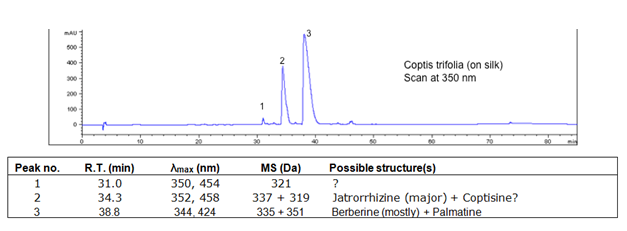Goldthread (Coptis trifolia ) LC
Description
Goldthread is a perennial herb growing from slender bright yellow to orange rhizomes. Goldthread grows in wet coniferous and mixed forests, bogs, willow scrub and tundra, in areas include Japan, China, Korea, Eastern Siberia and North America [1].
Historical importance
Goldthread, like all photoberberin dyes, is used as a direct dye, in a hot dye-bath, to obtain a bright golden yellow on silk or wool. The Micmac of the Gaspe peninsula and Acadia boiled the rhizomes to dye yellow [2]. The French settlers in Canada adopted this dye for their woolen cloth [3]. Japanese used Coptis japonica as a traditional dye.
Summary of results
Analytical instrumentation and procedures
HPLC-DAD-MS analysis was performed with an Agilent 1100 liquid chromatography system consisting of an automatic injector, a gradient pump, a HP series 1100 DAD, and an Agilent series 1100 VL on-line atmospheric pressure ionization electrospray ionization mass spectrometer. Separations were done on a Vydac 214TP52 analytical column (2.1 mm diameterX250 mm; 5-ím particle size). The column was eluted at a flow rate of 0.2 mL/min with a tertiary gradient of water (A),acetonitrile (B), and 1% (v/v) aqueous formic acid (C) with the following elution program: 0 min, 90% A, 5% B, 5% C; 0-55 min, a linear gradient to 35% A, 60% B, 5% C; 55-60 min, a linear gradient elution to 15% A, 80% B, 5% C; 60-62 min, isocratic elution at 15% A, 80% B, 5% C; 62-70 min gradient elution to 90% A, 5% B, 5% C; and reequilibration with the latter solvent for 15 min. The mass spectrometer was run both in the negative and positive ion mode.
Chromatograms
Sample information
Identified compounds
| Compound | RT (min.) | MW | UV/vis | Other |
|---|---|---|---|---|
| Berberine | 38.8 | 335 | 344,424 | Major compound |
| Palmatine | 38.8 | 351 | 344,424 | Co-elute with Berberine, could be detected with extracted ion mass. |
| Jatrorrhizine | 34.3 | 337 | 352,458 | Major compound |
| Coptisine | 34.3 | 319 | 352,458 | possible |
References
[1] Cardon, Dominique. "Natural dyes, sources, Traditions, Technology and Science" 331 (2007).
[2] Whitehead, R. H. (1982) Micmac Quillwork; Micmac Indian Techniques of Porcupine Quill Decration, 1600-1950. Halifax: Nava Scotia Museum. p. 68;
[3] Yamazaki K. The illustrated book of dye plants, vol. 1 (1985/2002). pp. 46-7.


